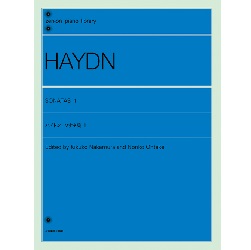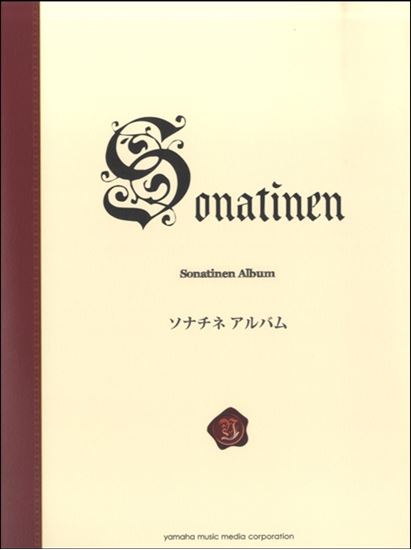Home > omnibus > Sonatine Album 1 > Sonate für Klavier Nr.48 C-Dur
Haydn, Franz Joseph : Sonate für Klavier Nr.48 C-Dur Hob.XVI:35 op.30-1
Work Overview
Publication Year:1780
First Publisher:Artaria
Instrumentation:Piano Solo
Genre:sonata
Total Playing Time:13 min 00 sec
Copyright:Public Domain
Additional Notes:第48番は「ウィーン原典版」の番号
Original/Related Work: omnibus 《Sonatine Album 1》
Commentary (2)
Author : Ooi, Kazurou
Last Updated: March 12, 2018
[Open]
Author : Ooi, Kazurou
Haydn's music is, first and foremost, optimistic. It possesses elegance, and incorporates operatic and string quartet elements, but what is most important to understand is that Haydn was a composer full of humor, who loved to surprise people. With this understanding, let us examine the score. At the beginning, you may imagine a string quartet or the voice of a female singer. In any case, heaviness is forbidden; it is crucial to play staccatos as lightly as possible and dotted rhythms lightly. Haydn's unique and delightful surprises, such as sudden fortes, abrupt modulations, and unexpected chords, can be found throughout. For example, the second beat of measure 7 is a V7 chord, which should ideally resolve to the tonic chord in measure 8. However, Haydn has placed a forte marking in the left hand. This can certainly be interpreted as a subito forte. I believe both the right-hand melody and the left-hand accompaniment can be played forte. Measure 16 is clearly a string quartet passage. Imagine strings and play so that the music flows horizontally, while maintaining the polyphonic order. I believe the technically challenging parts of this sonata are the turns. Play the turns that appear throughout without any missing notes or unevenness. Furthermore, attention must be paid to octave passages, such as those in the right hand at measure 42. Treat them melodically and be careful not to play them stiffly. Also, be careful not to overdo the forte markings found in many places. Always maintain elegance. When transitioning from measure 90 to measure 91, although measure 91 becomes octaves, ensure that it does not suddenly become loud. The crescendo begins at measure 86. Gradually increase the volume, aiming for such a smooth entry into measure 91 that the octaves are barely noticed. At measure 105, in the recapitulation, play the melody with a full, robust tone, as if a portly gentleman were singing. Personally, I believe the loudest passage in this movement is between measures 150 and 151. The first left-hand chord in measure 150 can also be played loudly. It is a surprising moment. Many fermatas are found throughout the piece. What the performer must consider is to view this movement as a single story, meticulously contemplating the mood of each fermata and other sections. Imagine what kind of conversation each part represents, what its mood is, and what characters are present. There is no serious discourse. Consider it a truly local, elegant, and optimistic conversation.
Author : Saitoh, Noriko
Last Updated: August 1, 2007
[Open]
Author : Saitoh, Noriko
The exact year of composition is unknown, but it is known to have been composed before 1780, as it was published in Vienna in that year as "Sonata Collection Vol. 1" along with works up to Hob. XVI/39. This sonata collection is dedicated to the Auenbrugger sisters. It consists of three movements.
Movement 1
The first movement is Allegro con brio, in 2/2 time and C major. It begins with a very concise melodic figure. In the development section (from m. 68), it is interesting to note that the first theme is developed in the order of its latter half followed by its first half. Furthermore, in the recapitulation (from m. 104), when the rhythm is varied, it shifts to C minor, the parallel minor.
Movement 2
The second movement is Adagio, in 2/2 time and F major. After an introduction in m. 8, the theme is presented in C major, the dominant key. Subsequently, after a middle section derived from the introduction, the theme is presented again, this time in the tonic key. The theme consists of a single melody, with only double notes in thirds appearing at its end.
Movement 3
The third movement is Allegro, in 3/4 time and C major. It is written in ternary form. The main theme is based on a stepwise progression from the third of the tonic chord towards the root. This melodic figure is used and developed at various pitches throughout the movement. The middle section begins at m. 26, and the recapitulation of the opening section begins at m. 70. In the middle section, G major (the dominant key) and C minor (the parallel minor) are observed.
Movements (3)
PTNA & Partner Channel Videos(2items)
Sheet MusicView More
Scores List (27)

(株)音楽之友社

カワイ出版

(株)全音楽譜出版社

(株)全音楽譜出版社

(株)春秋社

(株)ドレミ楽譜出版社

(株)ヤマハミュージックエンタテインメントホールディングス

(株)全音楽譜出版社

(株)ドレミ楽譜出版社

(株)ドレミ楽譜出版社

(株)ドレミ楽譜出版社

(株)ドレミ楽譜出版社

(株)ドレミ楽譜出版社

ヘンレー

(株)音楽之友社

ヘンレー

ヘンレー

(株)ドレミ楽譜出版社

(株)ヤマハミュージックエンタテインメントホールディングス

ヘンレ社(ヤマハ)

(株)全音楽譜出版社

ヘンレー

(株)音楽之友社

(株)音楽之友社





